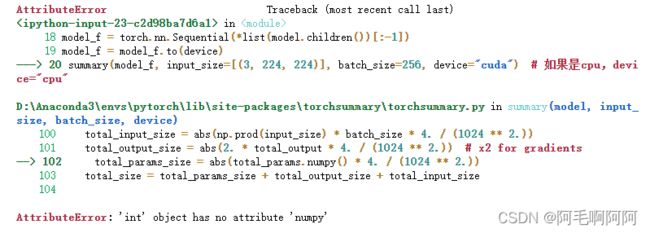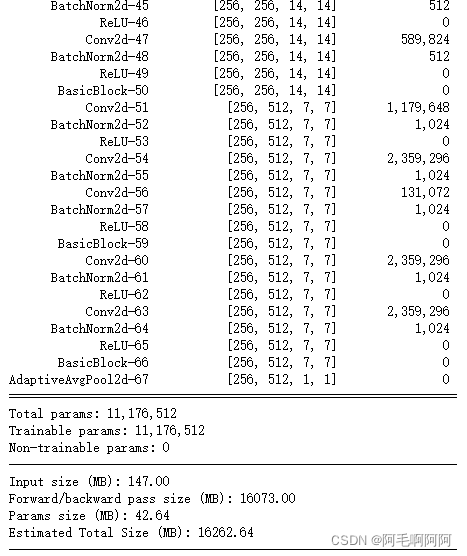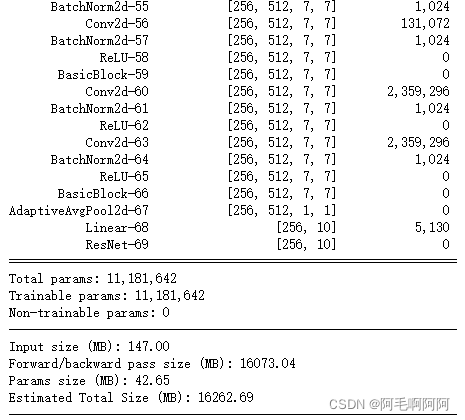【很简单的教程】如何提取模型每层的特征【以ResNet为例】
介于CSDN上没有人很详细地讲述如何提取特征,所以我踩了很多坑,本文教程是我踩坑的心路历程,最后面有提取特征的方法实例,不过建议从头阅读。
方法1
以一个十分类的问题为例,我最开始用于提取特征的方法是这样的:
class model(nn.Module):
def __init__(self):
super(model, self).__init__()
self.model1 = torchvision.models.resnet18(pretrained=None) #512->1000
self.model1.fc = nn.Linear(512, 64)
self.linear2 = nn.Linear(64, 10)
self.ReLU = nn.ReLU()
def forward(self, x):
x1 = self.model1(x)
x2 = self.ReLU(x1)
x3 = self.linear1(x2)
x4 = self.ReLU(x3)
x5 = self.linear2(x4)
return x1/x2/x3/x4【通过设置不同的返回值,从而实现想要提取的特征】
device = torch.device("cuda:0" if torch.cuda.is_available() else "cpu")
model = model.to(device)
feature = model(x) 【x是一个输入,对x的处理这里略过,通过model()的定义,输出及为x的特征】
上述的特征提取方法发挥出了作用,但是存在瓶颈——如果我想输出resnet18中的某层的特征,这种方法是行不通的。
试错:
我在网上查到一个方法,用torch.nn.Sequential(*list(cnn.children())[:-1])来提取resnet导数第一层的特征。
于是以resnet18为例,我用torch.nn.Sequential(*list(cnn.children())[:-1])尝试提取特征:
class model(nn.Module):
def __init__(self):
super(model, self).__init__()
self.model = torchvision.models.resnet18(pretrained=None) #512->1000
self.model.fc = nn.Linear(512, 10)
def forward(self, x):
x1 = self.model(x)
return x1
device = torch.device("cuda:0" if torch.cuda.is_available() else "cpu")
model = model()
model = model.to(device)
# 查看模型结构
summary(model, input_size=[(3, 224, 224)], batch_size=256, device="cuda") # 如果是cpu,device="cpu"
为了提取fc层前的维度为512的特征,我添加下面代码:
model_f = torch.nn.Sequential(*list(model.children())[:-1])
model_f = model_f.to(device)
summary(model_f, input_size=[(3, 224, 224)], batch_size=256, device="cuda") # 如果是cpu,device="cpu"
出现报错:

为了我检查torch.nn.Sequential(*list(model.children())[:-1])代码是否错误,于是运行下列代码:
for child in model_f.children():
print(child)
print('#######################')
我发现输出为空!也就是什么都没输出。
于是检查:
for child in model.children():
print(child)
print('#######################')
输出为:

于是我发现model的children()是一个大的整体,名为ResNet,这样的话我根本没办法提取每层的特征啊。
发现问题所在
后面通过尝试,我找到了问题出现的根本原因,是我重新定义模型导致的。
改正方法如下:
device = torch.device("cuda:0" if torch.cuda.is_available() else "cpu")
model = resnet18(pretrained=None)
model.fc = nn.Linear(512, 10)
model = model.to(device)
model_f = torch.nn.Sequential(*list(model.children())[:-1])
model_f = model_f.to(device)
summary(model_f, input_size=[(3, 224, 224)], batch_size=256, device="cuda") # 如果是cpu,device="cpu"
输出为:

可以看到fc层不见了!这样输出后的结果就是512维的特征!所以是模型定义的问题!
.
最后,我再给出一个函数定义,它可以被用于提取任意层的特征,思路不变,里面代码含义就不再具体讲了:
def build_resnet(feature_type):
cnn = torchvision.models.resnet152(pretrained=True)
if feature_type == 'pool5':
model = torch.nn.Sequential(*list(cnn.children())[:-1])
elif feature_type == 'res5c':
model = torch.nn.Sequential(*list(cnn.children())[:-2])
elif feature_type == 'res4c':
layers = list(cnn.children())[:-3]
layers.append(nn.AvgPool2d(kernel_size=3, stride=2, padding=1))
model = torch.nn.Sequential(*layers)
elif feature_type == 'pool4':
layers = list(cnn.children())[:-3]
layers.append(nn.AdaptiveAvgPool2d((1, 1)))
model = torch.nn.Sequential(*layers)
model = model.cuda()
model.eval()
return model
.
.
实践中,提取特征的模型很难传入训练好的参数,因为参数名字很难对应,这里我的解决办法是先传到正常的不删减的模型,传入参数后再进行特征提取网络的提取:
device = torch.device("cuda:0" if torch.cuda.is_available() else "cpu")
model = resnet18(pretrained=None)
model.fc = nn.Sequential(nn.Linear(512, 256), nn.ReLU())
model.fc.add_module('linear-71', nn.Sequential(nn.Linear(256, 128), nn.ReLU()))
model.fc.add_module('linear-72', nn.Sequential(nn.Linear(128, 10)))
state_dict = torch.load('/root/Desktop/cifar-10/checkpoint/best_89.65_100.0.pth', map_location='cuda') #?????CPU
new2_state_dict = OrderedDict()
for k, v in state_dict.items():
namekey = k[7:] # ??module???
new2_state_dict[namekey] = v
model.load_state_dict(new2_state_dict)
# model_list = list(model.children())[:-1] + list(model.fc.children())[:-1]
#model_list = list(model.children())[:-1]
model_f_front = torch.nn.Sequential(*list(model.children())[:-1])
model_f_behind = torch.nn.Sequential(*list(model.fc.children())[:-2])
model = nn.DataParallel(model, device_ids=[0, 1])
model_f_front = nn.DataParallel(model_f_front, device_ids=[0, 1])
model_f_behind = nn.DataParallel(model_f_behind, device_ids=[0, 1])
model = model.to(device)
model_f_front = model_f_front.to(device)
model_f_behind = model_f_behind.to(device)
